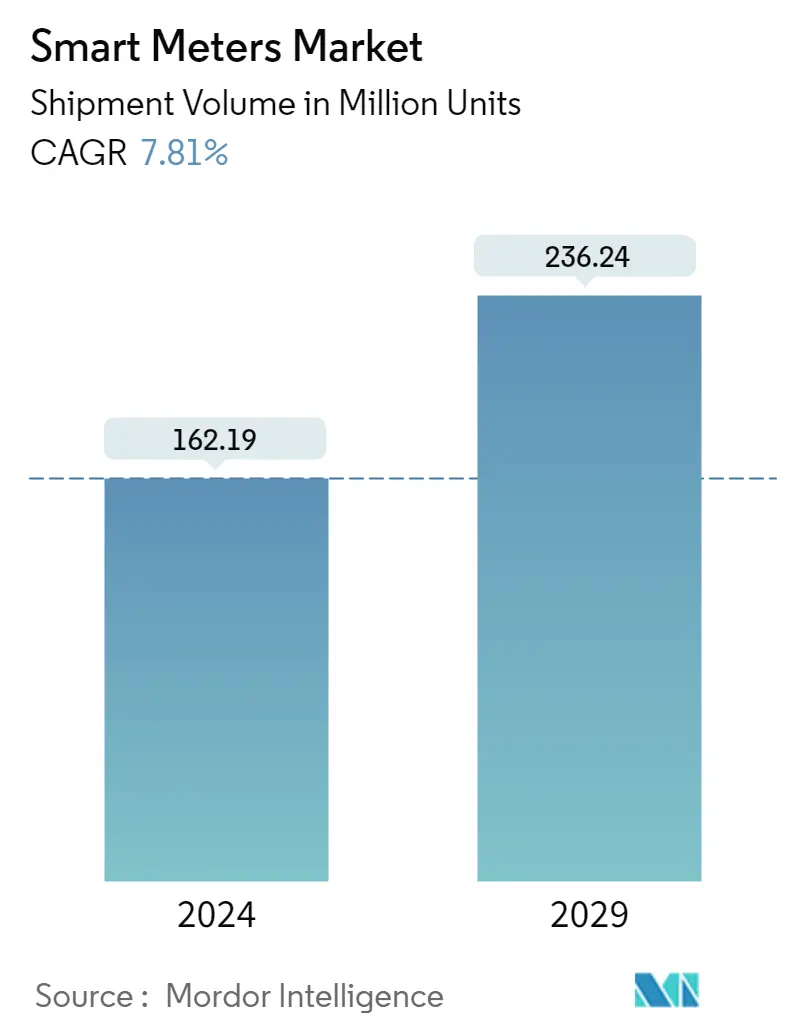Market Size of Smart Meters Industry

| Study Period | 2019 - 2029 |
| Base Year For Estimation | 2023 |
| CAGR (2024 - 2029) | 7.81 % |
| Fastest Growing Market | Asia Pacific |
| Largest Market | Asia Pacific |
| Market Concentration | Low |
Major Players
*Disclaimer: Major Players sorted in no particular order |
Smart Meters Market Analysis
The Smart Meters Market size in terms of shipment volume is expected to grow from 162.19 Million units in 2024 to 236.24 Million units by 2029, at a CAGR of 7.81% during the forecast period (2024-2029).
In order to increase the effectiveness of electrical networks, smart grids are being introduced all over the world. As a result, smart grids, which include smart electricity meters, are being deployed globally. To combat the negative impacts of pollution on the environment, nations all over the world are enacting emission control rules. This is the main factor driving the market.
- Due to their two-way communication capability, smart meters are being adopted more widely across the globe for various deployments, including electricity, gas, and water. This feature allows both utility suppliers and consumers to track utility usage in real-time and encourages suppliers to start, read, or cut off supply remotely.
- Consumer electronics, office equipment, and other plug loads consume nearly 15% to 20% of the total residential and commercial electricity while not in the primary mode. Most of this energy is consumed when they operate in low-power modes (even while they are not in use). Consumers are increasingly tending to install a smart energy management system to track such scenarios.
- Smart meters deployment also enables the implementation of a Home Energy Management System (HEMS) or Building Energy Management System (BEMS) that allows visualization of the electric power usage in individual homes or entire buildings.
- Further, digitization is accelerating and modernizing energy efficiency measures, due to which the deployment of smart grids is increasing globally, as they are capable of dynamically optimizing supply and fostering supply of large amounts of electricity from renewable energy sources such as solar power.
- Moreover, increasing government support and investments are expected to boost smart meters adoption and deployment in the country. For instance, India's state-owned Energy Efficiency Services Limited (EESL) completed the installation of approximately 10 lakh smart meters across India under the Government of India's Smart Meter National Programme. EESL set the target to install 25 crore smart meters over the next few years. Also, the need to establish a manufacturing base of smart electricity meters in the country to ensure an adequate supply of an adequate number of meters to be installed all over the country, by ruling out monopoly, is expected to act as a major driver.
- Lockdowns caused by the global COVID-19 epidemic caused a number of operations in many industries to come to a standstill. As a result, there was a decline in smart meter shipments and installations.
- However, as the COVID-19 requirements are gradually relaxed, it is anticipated that over time, the installation of smart meters will rise as well. The majority of energy providers are easily encouraging their consumers to update to smart meters in many developed locations.
Smart Meters Industry Segmentation
Smart meters are digital meters that represent a transformative technology for the utility industry and its customers. It enables either one-way or two-way communication between the meter and the supplier. These technologically advanced meters display real-time energy usage, provide greater insight into energy usage, and use a secure smart data network to automatically and wirelessly send the readings to the energy supplier to generate accurate bills.
The scope of the study includes the shipment of various kinds of smart meters, including smart gas, smart water, and smart electricity meters. The market size is calculated based on the unit shipments of the meters. In addition, the study analyzes the impact of COVID-19 on the market.
The smart meters market is segmented by smart gas meters (North America (United States, Canada & Central America), Europe (United Kingdom, France, Italy, and the Rest of Europe), Asia Pacific (China, Japan, and the Rest of Asia Pacific), Rest of the World), by smart water meters (North America (United States, Canada & Central America), Europe (United Kingdom, France, Italy, and the Rest of Europe), Asia Pacific (China, Japan, and the Rest of Asia Pacific), Rest of the World), by smart electricity meters (North America (United States, Canada & Central America), Europe (United Kingdom, France, Italy, and the Rest of Europe), Asia Pacific (China, Japan, and the Rest of Asia Pacific), Rest of the World). The market sizes and forecasts are provided in terms of value in USD for all the segments.
| By Geography - Smart Gas Meter | ||||||
| ||||||
| ||||||
| ||||||
| Rest of the World |
| By Geography - Smart Water Meter | ||||||
| ||||||
| ||||||
| ||||||
| Rest of the World |
| By Geography - Smart Electricity Meter | ||||||
| ||||||
| ||||||
| ||||||
| Rest of the World |
Smart Meters Market Size Summary
The smart meters market is poised for significant growth, driven by the global shift towards smart grids and the increasing emphasis on energy efficiency and emission control. Smart meters, with their two-way communication capabilities, are being widely adopted for electricity, gas, and water management, allowing real-time tracking of utility usage. This technology is integral to the implementation of Home Energy Management Systems (HEMS) and Building Energy Management Systems (BEMS), which help visualize and optimize energy consumption. The push for digitization and modernization of energy systems, coupled with government support and investments, is further propelling the deployment of smart meters. Countries like India are making substantial strides in this direction, with initiatives to install millions of smart meters as part of national programs.
In the Asia-Pacific region, China leads the market with extensive government mandates, although its rapid deployment phase is nearing completion. Japan is also making significant investments in smart grid technology to reduce carbon emissions, with plans to install millions of smart meters nationwide. The competitive landscape of the smart meter market is characterized by the presence of major players and increasing investments, which are raising barriers to entry and intensifying competition. Strategic acquisitions and partnerships, such as those by Badger Meter Inc. and Diehl Metering Inc., are enhancing the capabilities and reach of smart meter solutions. As urbanization and smart home technologies expand, the demand for smart meters is expected to rise, fostering further growth in the residential segment globally.
Smart Meters Market Size - Table of Contents
-
1. MARKET INSIGHTS
-
1.1 Market Overview
-
1.2 Industry Attractiveness - Porter's Five Forces Analysis
-
1.2.1 Bargaining Power of Suppliers
-
1.2.2 Bargaining Power of Buyers
-
1.2.3 Threat of New Entrants
-
1.2.4 Threat of Substitute Products
-
1.2.5 Degree of Competition
-
-
1.3 Industry Value Chain Analysis
-
1.4 Impact of COVID-19 on the Industry
-
-
2. MARKET SEGMENTATION
-
2.1 By Geography - Smart Gas Meter
-
2.1.1 North America
-
2.1.1.1 United States
-
2.1.1.2 Canada and Central America
-
-
2.1.2 Europe
-
2.1.2.1 United Kingdom
-
2.1.2.2 France
-
2.1.2.3 Italy
-
2.1.2.4 Rest of Europe
-
-
2.1.3 Asia Pacific
-
2.1.3.1 China
-
2.1.3.2 Japan
-
2.1.3.3 Rest of Asia Pacific
-
-
2.1.4 Rest of the World
-
-
2.2 By Geography - Smart Water Meter
-
2.2.1 North America
-
2.2.1.1 United States
-
2.2.1.2 Canada and Central America
-
-
2.2.2 Europe
-
2.2.2.1 United Kingdom
-
2.2.2.2 France
-
2.2.2.3 Italy
-
2.2.2.4 Rest of Europe
-
-
2.2.3 Asia-Pacific
-
2.2.3.1 China
-
2.2.3.2 Japan
-
2.2.3.3 Rest of Asia-Pacific
-
-
2.2.4 Rest of the World
-
-
2.3 By Geography - Smart Electricity Meter
-
2.3.1 North America
-
2.3.1.1 United States
-
2.3.1.2 Canada and Central America
-
-
2.3.2 Europe
-
2.3.2.1 United Kingdom
-
2.3.2.2 France
-
2.3.2.3 Italy
-
2.3.2.4 Rest of Europe
-
-
2.3.3 Asia Pacific
-
2.3.3.1 China
-
2.3.3.2 Japan
-
2.3.3.3 Rest of Asia Pacific
-
-
2.3.4 Rest of the World
-
-
Smart Meters Market Size FAQs
How big is the Smart Meters Market?
The Smart Meters Market size is expected to reach 162.19 million units in 2024 and grow at a CAGR of 7.81% to reach 236.24 million units by 2029.
What is the current Smart Meters Market size?
In 2024, the Smart Meters Market size is expected to reach 162.19 million units.

